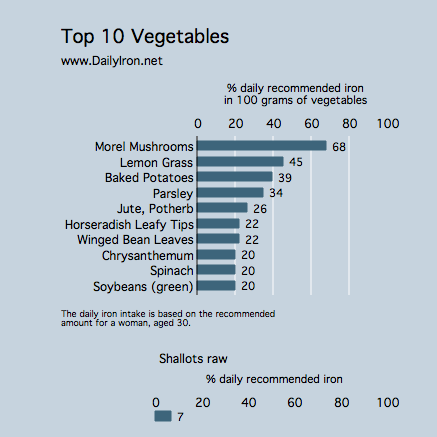Shallots contain 1.2 milligrams of iron per 100 grams. Grams is a measure of weight. To put 100 grams in perspective, consider alternative measures for this food:
- 1 tbsp equals 10 grams.
In the category of vegetables, we included whole vegetable products in the Top 10 list. We excluded dried/dehydrated products from the Top 10. You will find some dehydrated vegetables high in iron per 100 grams,but they tend to be far more volume than anyone would consume. Furthermore, foods may be fortified with iron but are not included in this Top 10 list. The food tested for the particular graph below can be described more specifically as:
Shallots, raw
Read more about iron in vegetables or visit our iron-rich foods list.

Vegetables on the whole are not an excellent iron source. Those vegetables that have a high content of iron also are likely to be high in iron inhibitors — you may not take in a great deal of the iron from the vegetables.
On the other hand, even a vegetable with little iron may play an important role in your body’s ability to metabolize iron. Vegetables can often be a good source of vitamin C, a vitamin that will actually help you metabolize the iron more completely in your vegetarian foods; shallots are a poor source of vitamin C.
Notwithstanding, for instance you may wish to combine vine ripened tomatoes and green peppers with a whole grain main dish or with beans to improve your digestion of the iron in your entire meal. A fresh pineapple salad with your dinner would also increase your iron metabolism because of the fruit’s vitamin C content. A glass of fruit juice is another an effective move.